Your car, a trusty companion on countless journeys, holds not only the key to your mobility but also a financial connection to your lender. When you’re still making payments on your vehicle, the lender becomes more than a partner in your transportation; they have a stake in your car, too. This unique dynamic creates a set of considerations when you need a title loan on a financed car, or decide to part ways with your vehicle. In this exploration, we’ll delve into the less-traveled path of selling your car while you still have a loan, uncovering the intricacies and possibilities along the way.
The Lender’s Stake: Understanding the Connection
When you finance a car through a lender, it’s not just a financial transaction; it’s a shared journey. In a sense, the lender becomes a partial owner of the vehicle. Their interest is safeguarded through the vehicle’s title, which may bear their name or be held in their possession until the loan is fully repaid. This ensures that you can’t simply sell the vehicle and transfer the title to a new owner without addressing the lender’s financial interest in the process.
The Intricacies of Selling a Financed Car
Selling a car with an outstanding loan is a nuanced process that involves multiple steps and considerations:
1. Determining the Payoff Amount: Before listing your vehicle for sale, contact your lender to ascertain the exact payoff amount. This figure represents the remaining balance on your loan, including principal and interest. It’s crucial to have this information to understand the financial landscape of your sale.
2. Price Evaluation: Assess the current market value of your vehicle. Understanding its worth will help you determine a fair selling price that not only covers the remaining loan balance but also leaves room for negotiations.
3. Communicate with Potential Buyers: When advertising your car for sale, be transparent about the existing loan. Inform potential buyers that there is an outstanding balance on the vehicle and that you will work to settle it upon the sale.
4. Handling the Sale: When you find a buyer, you have a few options to address the outstanding loan:
- Payoff the Loan: If you have the financial means, you can pay off the remaining loan balance before transferring the title to the new owner. Once the loan is settled, you can complete the sale, and the new owner will receive a clean title.
- Arrange a Loan Assumption: Some lenders may allow the new owner to assume the existing loan. In this scenario, the buyer takes over the remaining loan payments, and the title is transferred with the lender’s consent.
- Escrow Services: Consider using an escrow service to facilitate the sale. The service holds the buyer’s payment until the loan is paid off, ensuring a smooth and secure transaction.
5. Completing the Sale: Once the financial aspect is addressed, complete the sale by transferring the title to the new owner and providing any necessary documentation.
A Unique Journey: Selling Your Car with an Outstanding Loan
Selling a financed car is unlike selling a vehicle that’s fully owned. It involves collaboration with your lender, transparency with potential buyers, and careful navigation of the financial landscape. While the process may seem intricate, it’s entirely manageable with proper planning and communication. By understanding the lender’s stake and following the necessary steps, you can smoothly transition from car owner to seller, setting off on a unique journey that ensures all parties are on the same page before the final keys are handed over.

